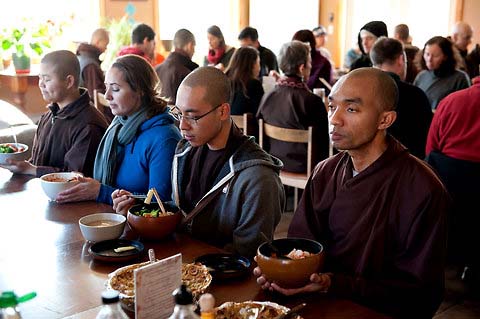Mindful eating has hit the New York Times!
One of our sharp-eyed editors spied this article yesterday in the Dining and Wine section of the Gray Lady: “Mindful Eating as Food for Thought.” In it, Jeff Gordinier writes about his visit to the Blue Cliff Monastery in Pine Bush, N.Y., where he participated in a silent, vegan, mindfully-eaten lunch, something he found to be “captivating and mysterious.” (Afterward, he tweeted, “& yeah I tried this mindful eating thing @ the monastery. Very cool. But not easy. Even putting my fork down was hard!”)
But it’s not just the New York Times who has trumpeted mindful eating. As Gordinier says in the article,
A mindful lunch hour recently became part of the schedule at Google, and self-help gurus like Oprah Winfrey and Kathy Freston have become cheerleaders for the practice.
With the annual chow-downs of Thanksgiving, Christmas and Super Bowl Sunday behind us, and Lent coming, it’s worth pondering whether mindful eating is something that the mainstream ought to be, well, more mindful of. Could a discipline pioneered by Buddhist monks and nuns help teach us how to get healthy, relieve stress and shed many of the neuroses that we’ve come to associate with food?
Paragraphs like these tend to worry me. I like Oprah. And I think that it would be great if everyone was a little more mindful when they eat. But what I don’t like is entering a discussion of mindful eating based on its ability to help someone lose weight or get healthy.
To Gordinier’s credit, he strays away from this view, interviewing someone that Tricycle has featured in its own pages: Dr. Jan Chozen Bays, who wrote “Mindful Eating” for us back in 2009.
“This is anti-diet,” said Dr. Jan Chozen Bays, a pediatrician and meditation teacher in Oregon and the author of “Mindful Eating: A Guide to Rediscovering a Healthy and Joyful Relationship with Food.” “I think the fundamental problem is that we go unconscious when we eat.” (…)
Dr. Bays, the pediatrician, has recommendations that can sound like a return to the simple rhythms of Mayberry, if not “Little House on the Prairie.” If it’s impossible to eat mindfully every day, consider planning one special repast a week. Click off the TV. Sit at the table with loved ones.
“How about the first five minutes we eat, we just eat in silence and really enjoy our food?” she said. “It happens step by step.”
Sometimes, even she is too busy to contemplate a chickpea. So there are days when Dr. Bays will take three mindful sips of tea, “and then, O.K., I’ve got to go do my work,” she said. “Anybody can do that. Anywhere.”
Chozen Bays is also answering reader comments on the NYT website here. So far, this has been my favorite comment, speaking about this picture:

Way boring. It is easy to make delicious food from the best, healthy ingredients, and including wine, so that there is a lot of talk, some yelling, and lots of fun. Those pictures do not look fun. Buddhists need to laugh, and yell a bit more. — Johnny D., Washington State
Which, to his credit, made me laugh. So here’s one laughing Buddhist for you, Johnny.
In any case, articles like this one always have me on the fence, staggering between happiness that Buddhist practices are making their way into the wider American world and worry that they’ll be commodified, branded, and mainstreamed before we can even mindfully eat our lunch. What does everyone think? New York Times mindful eating: good news or bad?
Thank you for subscribing to Tricycle! As a nonprofit, we depend on readers like you to keep Buddhist teachings and practices widely available.